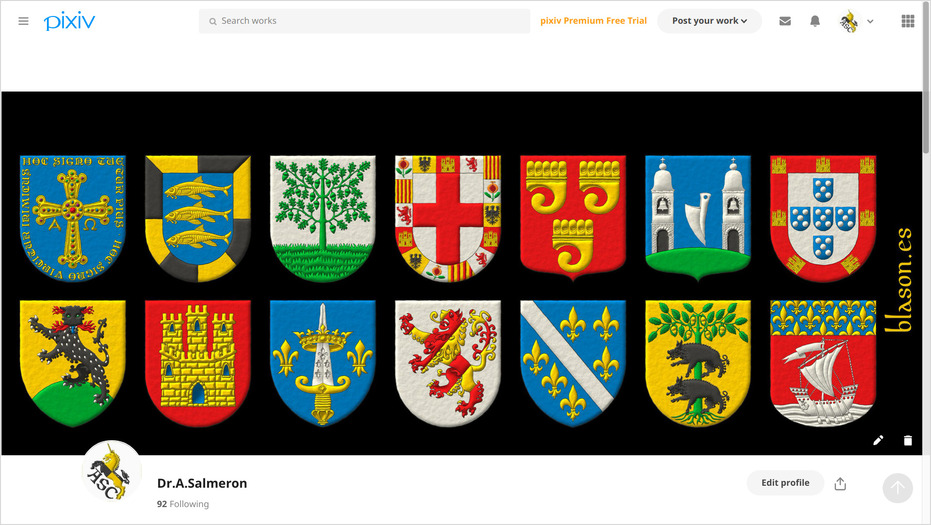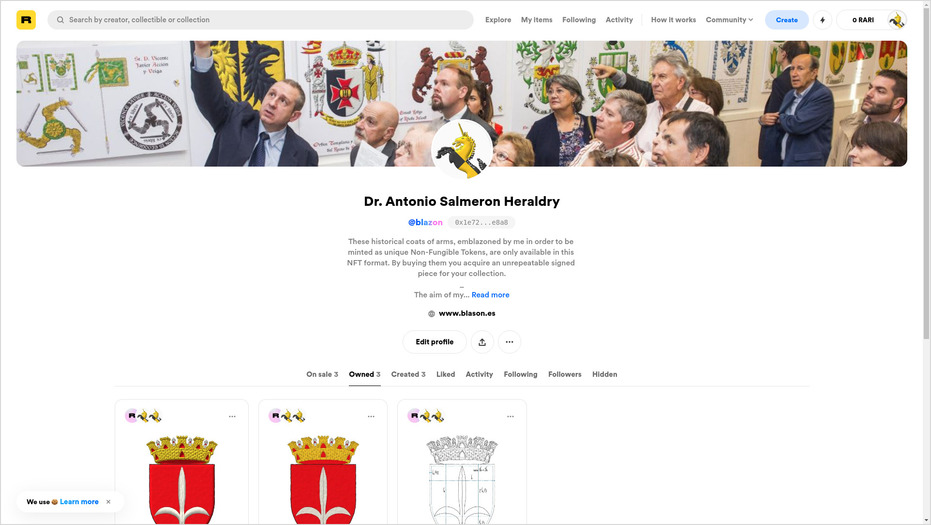Issuant from base


Albrecht Dürer

Gules, on a trimount issuant from the base Or, a port Gules, with canopy roof, jambs, enarched lintel, and two open leaves, upon a three-step stairway Oro.
Escudo de gules, un monte de tres peñas moviente de la punta sumado de una puerta con tejadillo, jambas, dintel arqueado, dos hojas abiertas sostenida de una escalinata de tres peldaños todo de oro, aclarada de gules.
Coat of arms painted by me, illuminated with lights and shadows, outlined in Sable, with an ogee external shape and with a freehand finish.
Coat of arms of Albrecht Dürer, 1471-1528, emblazoned by me based on the woodcut titled «Coat of Arms of Albrecht Dürer» made by Albrecht Dürer himself in 1523 on a sheet measuring 35.1 × 26.1 cm belonging to The Elisha Whittelsey Collection, The Elisha Whittelsey Fund, 1952, held at the Metropolitan Museum of New York, and on the work titled «Marriage Coat of Arms of the Families Duerer and Holper. Verso of the Albrecht Dürer the Elder portrait», dated 1490; Albrecht Dürer the Elder, 1427–1502, was his father.
Design rationale
The Dürer family coat of arms is an example of canting arms. Their family origin traces back to Ajtós, Hungary, a name which means «door» or «doorman» in Hungarian. Upon settling in Nuremberg, the family Germanized their surname to «Türer», derived from «Tür», meaning «door», and later to Dürer. This is the reason of the main charge of these arms.
Blazon keywords: Gules, One, Two, Three, On, Trimount, Issuant from base, Port, Canopy roof, Arched, Enarched, Upon, Step, Stairway and Port and windows.
Style keywords: Outlined in sable, Illuminated, Ogee and Freehand.
Classification: Personal, Lineage, Interpreted, Boa and Coat of arms.
Bearer: Albrecht Dürer.


Alejandra Espeja Avieda, schema 1x2
Or, four bell towers issuant from base Gules, windows Or.
Coat of arms of Alejandra Espeja Avieda designed by Juan Lanzagorta Vallín and emblazoned by me. As shown in the image, the structure of this coat of arms is based on the arms «Or shield with four pallets Gules» of Ramon Berenguer IV, Count of Barcelona, which are the arms of the Crown of Aragon. Regarding this coat of arms and my previous sentence, Joaquim Verde i Llorente tells me: «...or, four pallets gules, besides being the arms of the dynasty of the Counts of Barcelona (first found on a shield of Ramon Berenguer IV, although the proto-heraldic palleted design already appears on the Romanesque tombs of Ermesinda and Ramon Berenguer II), are those of the County of Barcelona / Principality of Catalonia and of the Crown of Aragon. But not of the Kingdom of Aragon, whose own kings considered that its ancient arms were the Cross of Íñigo Arista (senyal antich de rey d'Aragó ~ senyal antich d'Aragó ~ ancient emblem of the King of Aragon ~ ancient emblem of Aragon) and its modern arms the Cross of Alcoraz (armes d'Aragó ~ arms of Aragon). Although in the end, they ultimately became the quarterly shield of the Tree of Sobrarbe, the Cross of Íñigo Arista, the Cross of Alcoraz, and the Royal emblem (nostre senyal real ~ our royal emblem)...».
Blazon keywords: Or, Gules, Four, Pallet, Bell tower, Issuant from base and Port and windows.
Style keywords: Outlined in sable, Plain tincture and Semi-circular.
Classification: Personal, Interpreted, Schema, Boa and Coat of arms.
Bearer: Espeja Avieda, Alejandra.


Amitay Edward von Stiebel, outlined
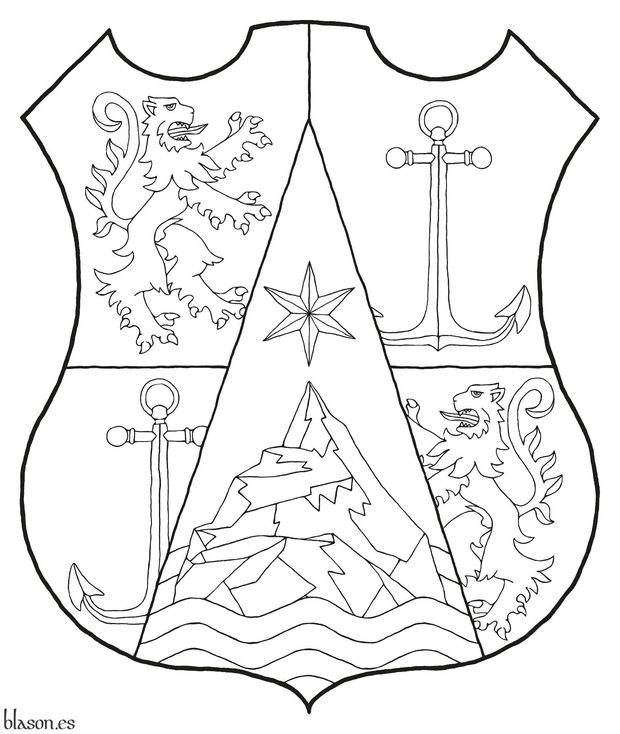
Quarterly: 1 Or, a lion rampant, facing sinister Sable, armed and langued Gules; 2 and 3 Gules, an anchor proper; 4 Or, a lion rampant Sable, armed and langued Gules; overall, a pile issuant from base Azure charged with a mount proper issuant from water issuant from base Argent, in chief, a mullet of six points Or.
Coat of arms of Amitay Edward von Stiebel outlined by me.
Blazon keywords: Or, Sable, Gules, Azure, Argent, One, Six, Quarterly, Lion, Rampant, Facing sinister, Armed, Langued, Anchor, Proper, Overall, Pile issuant from base, Charged, Mount, Issuant, Water, Issuant from base, In chief and Mullet.
Style keywords: Outlined and Bull's hide.
Classification: Personal, Interpreted, Boa and Coat of arms.
Bearer: Stiebel, Amitay Edward von.


Barrio Alto of Mon'Tarena
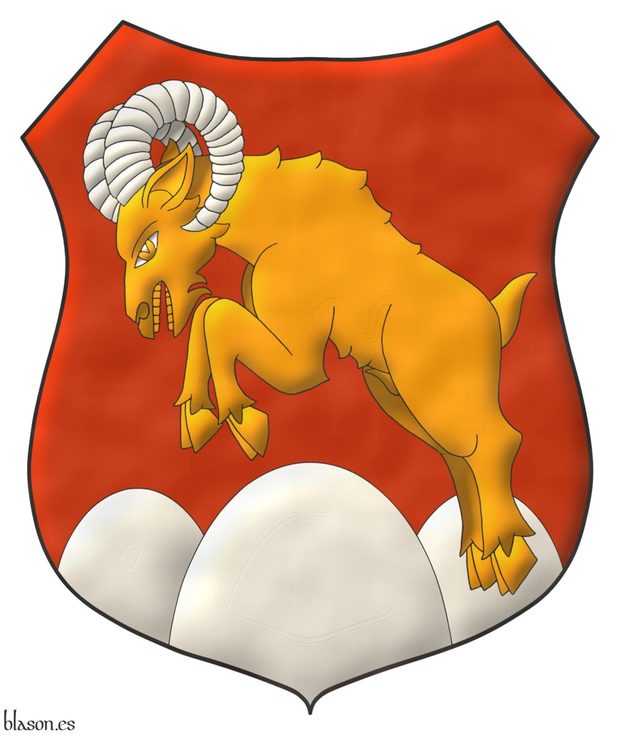
Gules, on a trimount issuant from the base Argent a bighorn sheep salient Or, horned Argent.
Escudo de gules, un monte de tres peñas moviente de la punta de plata sumado de un borrego cimarrón saltante de oro, acornado de plata.
Coat of arms designed by me, highlighted with lights and shadows, contoured in Sable, with a chasuble external shape and with a watercolor finish.
The coat of arms of the Barrio Alto of Mon'Tarena, Queretaro, Mexico, designed by Joaquin Haces Perdomo and me and emblazoned by me. The bighorn sheep is a symbol of strength and is native to the mountains of northern Mexico. Males, like the one depicted in this coat of arms, can weigh up to 300 lbs and are known for their impressive curved horns.
Blazon keywords: Gules, Or, Argent, One, On, Trimount, Issuant from base, Bighorn sheep, Salient and Horned.
Style keywords: Outlined in sable, Illuminated, Chasuble and Watercolor.
Classification: Civic, Created, Boa and Coat of arms.
Bearer: Barrio Alto of Mon'Tarena.


Crest of Marcio Vieira Nastri
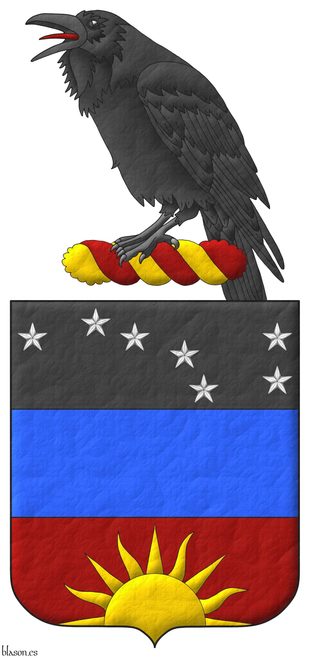
Tierced per fess: 1 Sable, seven mullets Argent arranged as the Plough of Ursa Major; 2 Azure; 3 Sanguine, a demi-sun issuant from base Or. Crest: Upon a wreath Or and Sanguine, a raven proper.
Arms painted by me, illuminated with lights and shadows, outlined in Sable, with an ogee external shape and with a leather finishing.
Blazon keywords: Sable, Azure, Sanguine, Argent, Or, Seven, One, Tierced per fess, Mullet, Plough of Ursa Major, Demi, Sun, Issuant from base, Crest, Upon (wreath), Wreath, Raven and Proper.
Style keywords: Outlined in sable, Illuminated, Ogee and Leather.
Classification: Personal, Interpreted, Boa and Coat of arms.
Bearer: Nastri, Marcio Vieira.


Full achievement of Jay Geoffrey De Graaf
Party per fess, 1 Gules, a stag rampant, issuant from base proper, in the dexter chief a Maltese cross Argent; 2 Azure, a mullet of seven points Argent. Crest: Upon a helm befitting his degree issuant from a crown of Noble above the shield, with a wreath Argent and Gules, a demi-lion Gules, crowned Or, grasping in its paws a swallow-tailed pennon lozengy Gules and Argent, shafted Sable. Mantling: Gules doubled Argent. Motto: «Per Aquas Ad Futurum». Suspended from the shield, the cross of Knight of Magistral Grace of the Sovereign Military Order of Malta.
Coat of arms painted by me, highlighted with lights and shadows, contoured in Sable, with a pointed external shape and with a freehand finish.
G0131, augmentation of G0042, Chief Herald of Arms of Malta's grant for the arms of Jay Geoffrey De Graaf, Australia. The augmentation consists of the addition of a Maltese cross Argent in the dexter chief. These arms have been emblazoned by me for such grant.
Blazon keywords: Gules, Azure, Argent, Or, One, Party per fess, Stag, Rampant, Issuant from base, Proper, In the dexter chief, Eight-pointed cross, Cross couped, Mullet, Crest, Upon (wreath), Helm, Issuant, Crown of Noble, Crown, Above the shield, Wreath, Demi, Lion, Crowned, Grasping, Paw, Swallow-tail, Lozengy, Shafted, Mantling, Motto, Suspended from the shield and Decoration.
Style keywords: Outlined in sable, Illuminated, Pointed and Freehand.
Classification: Personal, Interpreted, Boa, Coat of arms, Pennon and Flag.
Bearer: Graaf, Jay Geoffrey De.


Ignasi Pujol, comparation
[ Azure, a mount issuant from the base, in chief a fleur the lis Argent ] and [ Party per chevron Azure and Or, in chief a fleur de lis Argent, in base four pallets Gules ].
The coat of arms of Ignasi Pujol was designed by him based on the ancient arms of the Pujol lineage, 1st image, and refined and emblazoned by me, 2nd image. The comparison of the blazon of the Pujol lineage with the blazon for Ignasi Pujol is the following.
Blazon keywords: Azure, Argent, Or, Gules, One, Mount, Issuant from base, In chief, Party per chevron, Fleur de lis, In base, Pallet and Pale.
Style keywords: Outlined in sable and Illuminated.
Classification: Lineage, Personal, Compare, Interpreted, Coat of arms and Boa.
Bearer: Pujol, Ignasi.


Jonathan Pons Paneque, page of armorial

Quarterly: 1 and 4 Gules, a three arch bridge issuant from base and throughout Or; 2 and 3 Azure, five fleurs de lis, in base two bars wavy Or. Crest: A crown of the Sovereign and Most Noble Order of the Pomegranate. The shield is surrounded by the Grand Collar of the Sovereign and Most Noble Order of the Pomegranate.
This is his coat of arms of emblazoned by me for the Roll of Arms of the Sovereign and Most Noble Order of the Pomegranate.
Blazon keywords: Quarterly, Gules, One, Bridge, Issuant from base, Throughout, Or, Azure, Five, Fleur de lis, In base, Two, Fess, Wavy, Crest and mantling, Crown, Pomegranate, Surrounded and Grand collar.
Style keywords: Pointed, Outlined in sable, Illuminated and Leather.
Classification: Personal, Interpreted, Coat of arms, Armorial roll and Castilian language.
Bearer: Pons Paneque, Jonathan.


Motto of Tomasz Arkadiusz Grzeszkowiak
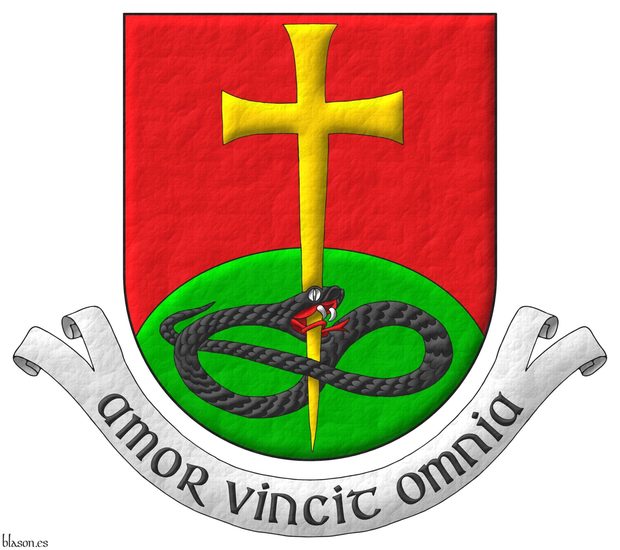
Gules, a base enarched Vert, overall a cross patty fitchy Or, piercing in base the head of a serpent nowed and facing sinister Sable, langued Gules. Motto: «Amor vincit omnia»
Blazon keywords: Without divisions, Gules, One, Mount, Vert, Issuant from base, Overall, Cross patty fitchy, Cross couped, Piercing, Head, Serpent, Nowed, Facing sinister, Sable, Langued and Motto.
Style keywords: Semi-circular, Leather and Outlined in sable.
Classification: Interpreted, Personal and Coat of arms.
Bearer: Grzeszkowiak, Tomasz Arkadiusz.


Norsk Heraldisk Forening, coat of arms
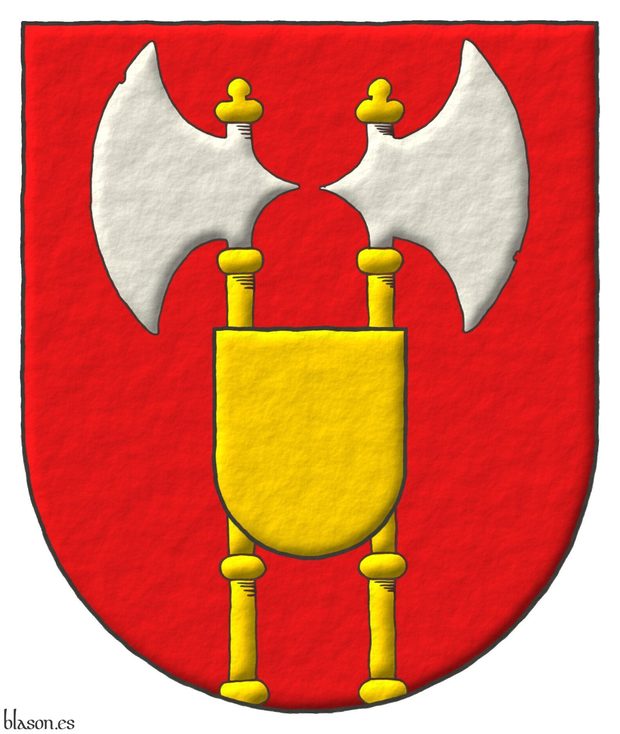
Gules, two axes addorsed Argent, hafted Or, issuant from the base; overall, at the nombril, an escutcheon Or.
Escudo de gules, dos hachas adosadas de plata, fustadas de oro, movientes de la punta; brochante sobre el todo, en el ombligo, un escudete de oro.
Interpretation I have made with the following characteristics: the escutcheon is semicircular, in the classic Castilian style; its field is illuminated with the tincture gules; its 2 axes and escutcheon are outlined in sable and illuminated with the metal Or, and the axe heads in Argent; and the execution is in a raised line style.
Hafted or shated
The term «hafted» in English is specifically used for weapons with handles, such as axes and hammers. This refers to the part of the weapon where the user grips, which is typically made of wood or metal and is essential for wielding the weapon effectively. The haft is integral to the weapon's function, providing the necessary leverage and control during use.
On the other hand, «shafted» is a term used in English for weapons with a shaft, which is a longer, slender part of the weapon, as seen in spears, arrows, and sometimes in lances. The shaft is usually the primary structural component, providing the length and reach, while also serving as the backbone of the weapon.
In both cases, the term indicates that this part of the weapon is of a different tincture from the rest of the figure.
In Castilian, however, both «hafted» and «shafted» translate to «fustadas», which broadly refers to a similar concept where the handle or shaft is of a different color than the head or blade.
Then, I prefer using «hafted» when referring to axes and hammers due to the specificity of the term in English.
This contrasts with the term «guarnezidas» ~ «hilted», which is used for swords, indicating a different color for the guard or hilt, rather than for the shaft or handle.
Addorsed, back to back
For the arrangement of the axes in relation to each other, the one on the dexter facing dexter, the one on the sinister facing sinister, I use the term «addorsed» as it is the most common, but I previously used «back to back», which is said of «two animals, rampant, with their backs against each other, each facing the opposite flank. Two keys are also described as back to back when they are positioned with the bits outward, each to its side; the same applies to sickles, or scythes and generally to all long objects that have two faces, like two axes...» [Avilés, J.; 1780a; page 98], this being the case for the axes in this shield.
«Dalla» is a synonym for «scythe» used in and originating from Aragon and Navarra, [Real Academia Española; 2001].
In the English blazon, «adosadas», «de espaldas», is rendered as «addorsed», from the French «adossé», which is said, for example, when «two animals turned back to back» and some also use «endorsed».
Blazon keywords: Without divisions, Gules, Axe, Argent, Hafted, Or, Addorsed, Issuant from base, Overall, At the nombril and Escutcheon.
Style keywords: Semi-circular, Illuminated, Outlined in sable and Freehand.
Classification: Interpreted, Socioeconomic and Coat of arms.
Bearer: Norsk Heraldisk Forening.


OpenSea
My heraldic NFTs in OpenSea opensea.io/DrASalmeronHeraldry.
These historical coats of arms, emblazoned by me in order to be minted as unique Non-Fungible Tokens, are only available in this NFT format. By buying them you acquire an unrepeatable signed piece for your collection.
Categories: Technology, Social networks, NFT, Gules, Halberd, Issuant from base and Argent.


Peregrina Corona, Dolores

Tierce: 1 Argent, two keys points upwards, in saltire, between in chief an escallop, and in base a mullet of five points environed at dexter by a crescent bendwise azure; 2 Azure, a dexter arm vested, issuant from sinister, grasping a pilgrim's staff palewise, issuant from base, tied to it a gourd bendwise Argent.
Escudo adiestrado: 1o de plata, dos llaves alzadas en sotuer, acompañadas en jefe de una venera, y en punta de una estrella de cinco puntas, circundada a la diestra de un creciente puesto en banda todo de azur; 2o de azur, un brazo diestro vestido, moviente de la siniestra, teniendo un bordón de peregrino puesto en palo, moviente de la punta, y atada a él una calabaza puesta en banda todo de plata.
Arms designed by me, in flat tinctures, contoured in Sable, with a semi-circular outer contour and with a texturized finishing.
Canting arms of Dolores Peregrina Corona designed by Juan Lanzagorta Vallín and me and emblazoned by me. In Castilian heraldic tradition, the «adiestrado» ~ «tierce» used in this coat of arms and its symmetrical «siniestrado» ~ «tierce sinister» are «irregular divisions of the field by one line» ~ «particiones irregulares». That is why I use «tierce» and «tierce sinister» in English. There is another possibility, which is to call the «adiestrado» ~ «pale in dexter flank» and the «siniestrado» ~ «pale in sinister flank», thus ceasing to be a type of «divisions of the field» ~ «particiones» and becoming «ordinaries» ~ «piezas fundamentales». This has implications, as the rule of tinctures would apply if it were considered a «pale» ~ «palo». In any case, I will write the blazon in both ways. Alternative blazon: Azure, a dexter arm vested, issuant from sinister, grasping a pilgrim's staff palewise, issuant from base, tied to it a gourd bendwise; on a pale in dexter flank Argent two keys points upwards, in saltire, between in chief an escallop, and in base a mullet of five points environed at dexter by a crescent bendwise azure.
Design rationale
These are canting arms because her surname is «Peregrina» ~ «pilgrim», and her coat of arms depicts the arm of a pilgrim, as she is one herself, with her staff and her gourd for carrying water, advancing towards the dexter, in order to reach the destination of her three most important life pilgrimages: Santiago de Compostela, Rome, and Jerusalem.
Blazon keywords: Azure, Argent, One, Two, Tierce, Key, Point upwards, In saltire, Between, In chief, Escallop, In base, Mullet, Environed, Dexter, Crescent, Bendwise, Arm, Vested, Issuant from the sinister flank, Grasping, Pilgrim's staff, Palewise, Issuant from base, Tied and Gourd.
Style keywords: Outlined in sable, Plain tincture and Semi-circular.
Classification: Personal, Created, Boa and Coat of arms.
Bearer: Peregrina Corona, Dolores.


Pixiv
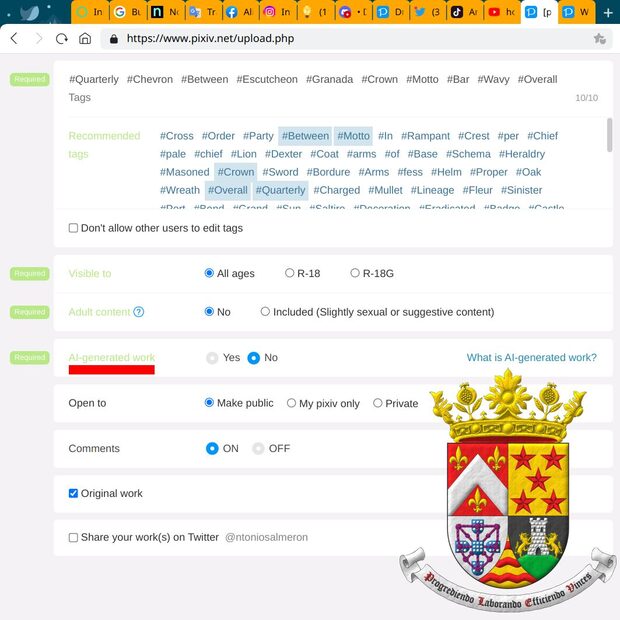
My heraldic Pixiv wall is Dr.A.Salmeron @antoniosheraldry and pixiv.me/antoniosheraldry.
Pixiv is a Japanese online community for artists. I post in Pixiv 2 or 3 coats of arms per week. They use a strict form to post with many mandatory input fields. This week, they have added a new mandatory field «AI-generated work: Yes / No», AI ~ Artificial Intelligence. In the image, I have highlighted this new field in red.
Categories: Technology, Social networks, Quarterly, Gules, One, Chevron, Argent, Between, Three, Fleur de lis, Or, Five, Mullet, In saltire, Four, Escutcheon, In cross, Azure, Charged, Nine, Bezant and plate, Two, Flank, Fesswise, Center, Overall, Carbuncle, Cord, In orle, Knotted, Purpure, Overall (all), Sable, Mount, Issuant from base, Vert, On, Tower, Port and windows, Masoned, Wolf, Supporting, Enté en point, Fess, Wavy, Crown of the Sovereign and Most Noble Order of the Pomegranate, Crown and Motto.


Rarible
My heraldic NFTs at Rarible rarible.com/blazon.
These historical coats of arms, emblazoned by me in order to be minted as unique Non-Fungible Tokens, are only available in this NFT format. By buying them you acquire an unrepeatable signed piece for your collection.
Categories: Technology, Social networks, NFT, Gules, Halberd, Issuant from base and Argent.


Taborda, Arturo
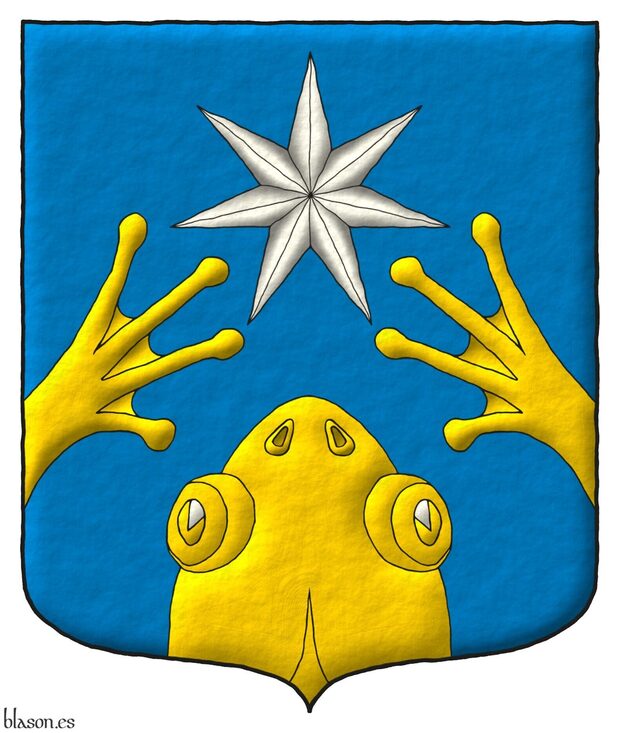
Azure, issuant from base a frog's head and from flanks its forelegs in chevron Or, in chief a mullet of seven points Argent.
Escudo de azur, moviente de la punta una cabeza de rana y de los flancos sus patas delanteras en chevron todo de oro, en jefe una estrella de siete puntas de plata.
Coat of arms interpreted by me, illuminated with lights and shadows, contoured in Sable, with an ogee external shape and with a freehand finishing.
Blazon keywords: Azure, Or, Argent, One, Seven, Issuant from base, Frog, Head, Flank, Foreleg, In chevron, In chief and Mullet.
Style keywords: Outlined in sable, Illuminated, Ogee and Freehand.
Classification: Personal, Interpreted, Boa and Coat of arms.
Bearer: Taborda, Arturo.
-
Language
-
Categories of heraldry
-
Divisions of the field
- Without divisions
- Party per pale
- Party per fess
- Party per bend
- Party per bend sinister
- Tierce
- Tierce sinister
- Tierced per pale
- Tierced per fess
- Tierced per bend
- Tierced pallwise inverted
- Quarterly
- Quarterly per saltire
- Gyronny
- Party per fess, the chief per pale
- Party per pale, the sinister per fess
- Party per fess, the base per pale
- Party per pale, the dexter per fess
- Chapé
- Chaussé
- Embrassé
- Contre-embrassé
- Party per chevron
- Enté
- Enté en point
- Flanched
-
Metals
-
Colours
-
Furs
-
Other tinctures
-
Ordinaries and sub-ordinaries
-
Diminutives of the ordinaries
-
Geometric charges
-
Composite ordinaries
-
Inanimate charges from Nature
Atom, Crescent, Diamond, Emerald, Estoile, Increscent, Lightning flash, Moon, Mount, Mullet, Mullet of four points, Orbital, Plough of Ursa Major, Rainbow, Ray of the sun, River, Sea, Snowflake, Sun, Sun in splendour, Sun of May, Trimount, Water and Wave.
-
Vegetal charges from Nature
Acorn, Apple, Apple tree, Ash, Bluebonnet, Camellia, Chrysanthemum, Cinquefoil, Cornflower, Dogwood flower, Double rose, Elm, Fleur de lis, Flower, Gourd, Holm oak, Hop cone, Indian paintbrush, Kapok tree, Laurel, Lily, Linden, Lotus flower, Madonna lily, Mexican cedar tree, Oak, Olive tree, Palm tree, Plantain plant, Pomegranate, Poplar leaf, Rose, Shamrock, Sunflower, Thistle, Tree, Tulip, Vine and Wheat.
-
Animal charges from Nature
Badger, Bald eagle, Barbel, Barn owl, Bear, Beaver, Bee, Beetle, Bighorn sheep, Binson, Blackbird, Boar, Brach hound, Bull, Doe, Dog, Dolphin, Dove, Eagle, Elephant, Falcon, Female figure, Fish, Flame, Fly, Fox, Frog, Goat, Goldfinch, Goose, Heron, Horse, Hummingbird, Jaguar, Lark, Leopard, Lion, Lion passant, Lion rampant guardant, Lioness, Lynx, Male figure, Martlet, Merino ram, Owl, Panther, Parrot, Peacock, Pelican, Pelican in her piety, Pronghorn, Puffin, Quetzal, Raven, Roe deer, Rooster, Savage, Seagull, Serpent, She-wolf, Stag, Starling, Talbot, Tyger, Vulture, Warren hound and Wolf.
-
Parts of natural charges
Arm, Beak, Branch, Caboshed, Chest, Claw, Covert, Dorsal fin, Eagle claw, Ermine spot, Escallop, Feather, Foot (palmiped), Foreleg, Forepaw, Hand, Head, Heart, Hoof, Leaf, Neck, Ostrich feather, Palm frond, Paw, Roe deers' attires, Shoulder, Sprig, Stags' attires, Stem, Swallow-tail, Tail, Tail addorsed, Tail fin, Talon, Tibia, Tooth, Trunk, Trunk (elephant), Two hands clasped, Two wings in vol, Udder, Wheat spike, Wing and Wrist.
-
Artificial charges
Ace of spades, Anchor, Anvil, Arch, Arm vambraced, Armillary sphere, Arrow, Axe, Bell, Bell tower, Beret, Bonfire, Book, Bookmark, Bow, Branding iron, Bridge, Broken, Buckle, Cannon, Cannon dismounted, Cannon port, Canopy roof, Carbuncle, Castle, Celtic Trinity knot, Chain, Chess rooks, Church, Clarion, Clay pot, Closed book, Club, Column, Comb, Compass rose, Conductor's baton, Cord, Covered cup, Crozier, Crucible, Cuffed, Cup, Cyclamor, Dagger, Double vajra, Drum, Ecclesiastical cap, Fanon, Federschwert, Fleam, Four crescents joined millsailwise, Galician granary, Garb, Gauntlet, Geometric solid, Grenade, Halberd, Hammer, Harp, Host, Hourglass, Key, Key ward, Knight, Knot, Lantern, Letter, Line, Loincloth, Menorah, Millrind, Millstone, Millwheel, Monstrance, Mortar, Mullet of six points pierced, Nail, Non-classic artifact, Norman ship, Number, Oar, Oil lamp, Open book, Page, Pair of scales, Parchment, Pestle, Piano, Pilgrim's staff, Plough share, Polish winged hussar, Port, Portcullis, Potent, Quill, Ribbon, Rosette of acanthus leaves, Sabre, Sackbut, Sail, Scroll, Scythe, Sheaf of tobacco, Ship, Skirt, Spear, Spear's head, Stairway, Star of David, Step, Sword, Symbol, Tetrahedron, Torch, Tower, Trident, Trumpet, Turret, Two-handed sword, Wagon-wheel, Water-bouget, Wheel, Winnowing fan and With a turret.
-
Immaterial charges
Angel, Archangel, Basilisk, Dragon, Dragon's head, Garuda, Golden fleece, Griffin, Heart enflamed, Justice, Mermaid, Our Lady of Mercy, Ouroboros, Paschal lamb, Pegasus, Phoenix, Sacred Heart of Jesus, Saint George, Sea-griffin, Trinity, Triton, Unicorn, Winged hand and Wyvern.
-
External elements
-
Heraldic creations
-
References
-
Formats
-
Keywords on this page
Port and windows, Between, Proper, Halberd, Facing sinister, Pointed, Azure, Boa, Overall, Wreath, Head, Charged, Upon (wreath), Crest, Five, Ogee, Crown, Created, Cross couped, Quarterly, Four, Outlined in sable, Two, In chief, In base, In saltire, Escutcheon, Coat of arms, Mullet, Fess, Flank, Fleur de lis, Personal, Gules, Illuminated, Interpreted, Motto, Semi-circular, Mount, Issuant from base, Or, Leather, Argent, Social networks, Sable, On, Technology, Freehand and One.

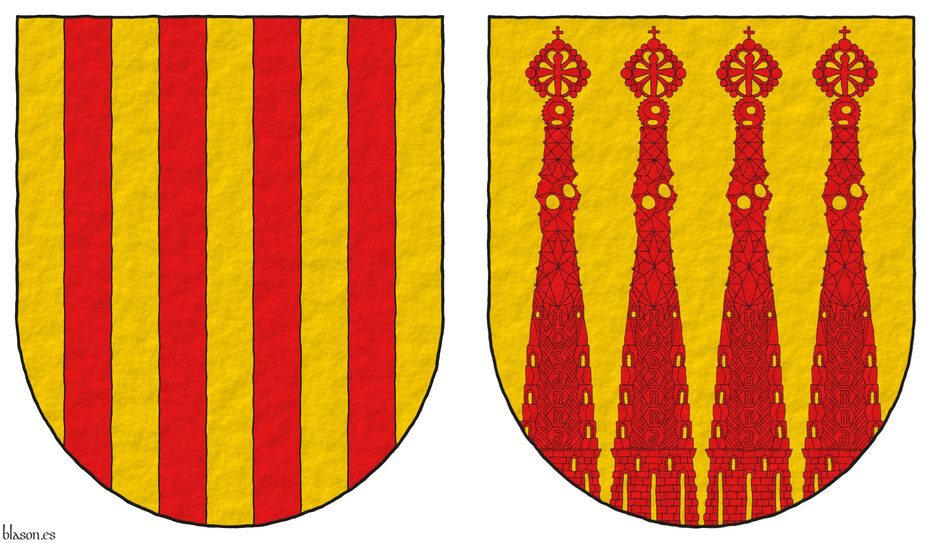
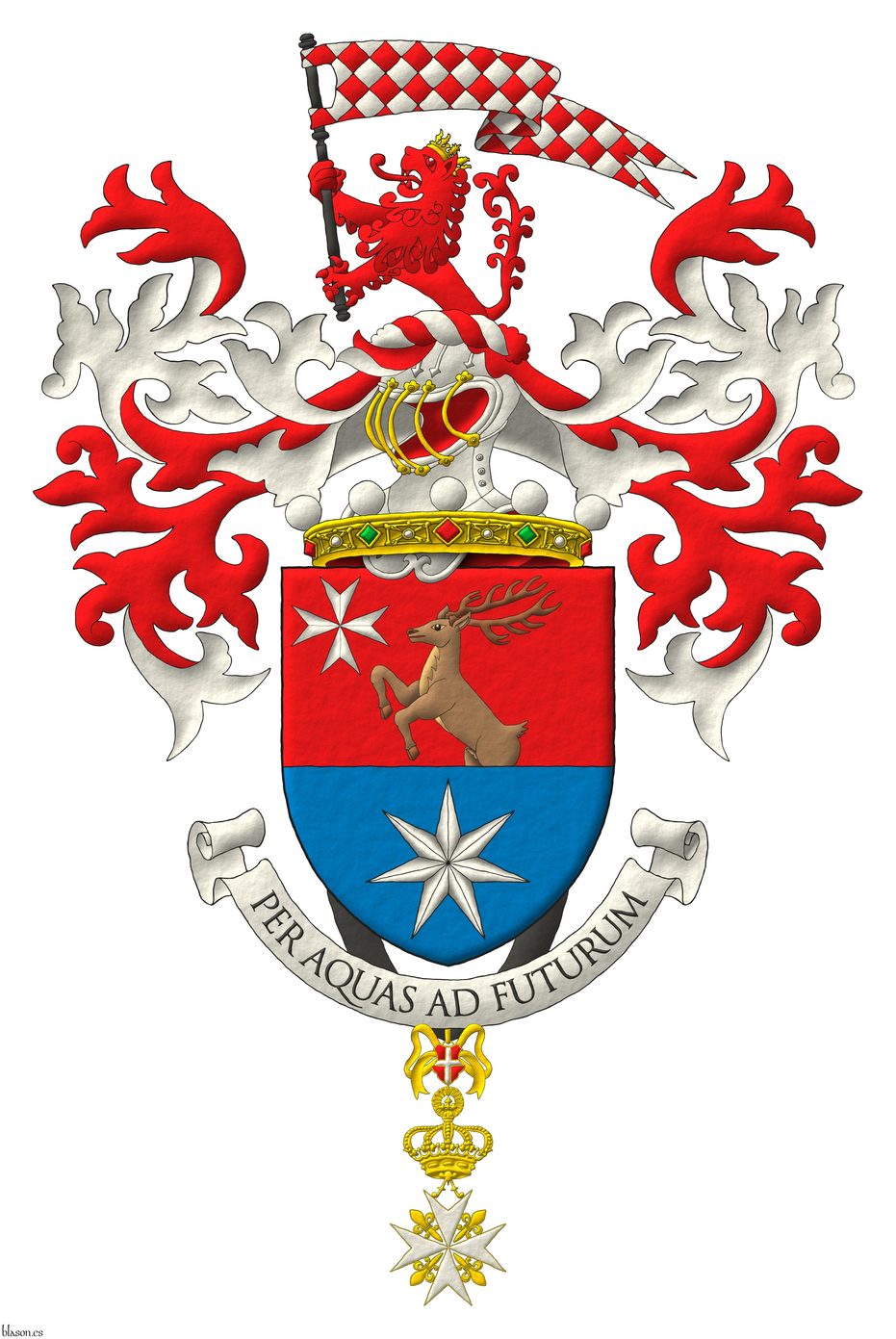
![Ignasi Pujol, comparation [ Azure, a mount issuant from the base, in chief a fleur the lis Argent ] and [ Party per chevron Azure and Or, in chief a fleur de lis Argent, in base four pallets Gules ].](../escudo_armas/PujolIgnasi.20.PujolLineage.Ogee.Compare.jpg)

